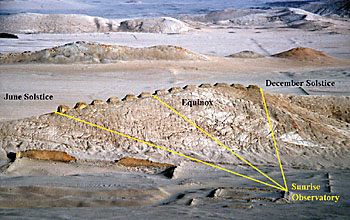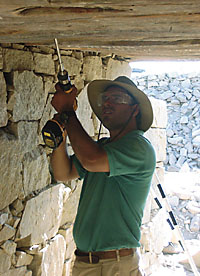 | By standing at the western solar observatory, the Inca could track the yearly movements of the sun -- shown here rising between Tower 1 and Cerro Mucho Malo at the June solstice in 2003. |
Archaeologists from Yale and the University of Leicester have identified an ancient solar observatory at Chankillo, Peru, as the oldest in the Americas, with alignments covering the entire solar year, according to an article in the March 2 issue of Science.
Recorded accounts from the 16th century A.D. detail practices of state-regulated sun worship during Inca times and related social and cosmological beliefs. These accounts mention towers being used to mark the rising or setting position of the sun at certain times in the year, but no trace of the towers has ever been found. This article reports the earliest structures that support those writings.
At Chankillo, not only were there towers marking the sun's position throughout the year, but they are still standing today. The site was constructed in approximately the 4th century B.C.
"Archaeological research in Peru is constantly pushing back the origins of civilization in the Americas," says Ivan Ghezzi, a graduate student in the Department of Anthropology at Yale and lead author of the paper. "In this case, the 2,300-year-old solar observatory at Chankillo is the earliest such structure identified and, unlike all other sites, contains alignments that cover the entire solar year. It predates the European conquests by 1,800 years and even precedes, by about 500 years, the monuments of similar purpose constructed by the Mayans in Central America."
Chankillo is a large ceremonial center covering several square kilometers in the coastal Peruvian desert. It was better known in the past for a heavily fortified hilltop structure with massive walls, restricted gates and parapets. For many years, there has been a controversy as to whether this part of Chankillo was a fort or a ceremonial center. But the purpose of a 300-meter long line of 13 towers lying along a small hill nearby had remained a mystery.
"Focusing on the Andes and the Incan empire, we have known for decades from archaeological artifacts and documents that they [the Inca] practiced what is called solar horizon astronomy, which uses the rising and setting positions of the sun in the horizon to determine the time of the year," says Ghezzi. "We knew that Inca practices of astronomy were very sophisticated and that they used buildings as a form of 'landscape timekeeping' to mark the positions of the sun on key dates of the year, but we did not know that these practices were so old."
According to archival texts, "sun pillars" standing on the horizon near Cusco were used to mark planting times and regulate seasonal observances, but these have vanished and their precise location remains unknown. In this report, the model of Inca astronomy, based almost exclusively in the texts, is fleshed out with a wealth of archaeological and archaeoastronomical evidence.
Ghezzi was originally working at the site as a Yale graduate student conducting thesis research on ancient warfare in the region, with a focus on the fortress at the site.
Noting the configuration of 13 monuments in 2001, Ghezzi wondered whether they had a relationship to Inca astronomy. "Since the 19th century, there was speculation that the 13-tower array could be solar or lunar demarcation -- but no one followed up on it," Ghezzi says. "We were there. We had extraordinary support from the Peruvian government, Earthwatch and Yale. So we said, 'Let's study it while we are here.'"
To his surprise, says Ghezzi, within hours he and others had measurements indicating that one tower aligned with the June solstice and another with the December solstice. But it took several years of fieldwork to date the structures and demonstrate the intentionality of the alignments. In 2005, Ghezzi connected with co-author Clive Ruggles, a leading British authority on archeoastronomy. Ruggles was immediately impressed with the monument structures.
"I am used to being disappointed when visiting places people claim to be ancient astronomical observatories," says Ruggles. "Since everything must point somewhere and there are a great many promising astronomical targets, the evidence -- when you look at it objectively -- turns out all too often to be completely unconvincing.
"Chankillo, on the other hand, provided a complete set of horizon markers -- the Thirteen Towers -- and two unique and indisputable observation points," Ruggles adds. "The fact that, as seen from these two points, the towers just span the solar rising and setting arcs provides the clearest possible indication that they were built specifically to facilitate sunrise and sunset observations throughout the seasonal year."
The researchers also knew that Inca astronomical practices in much later times were intimately linked to the political operations of the Inca king, who considered himself an offspring of the sun. They say this observatory may well have helped to support the social and political hierarchy in this earlier time because the people who used the monuments to track astronomical observances throughout the year were seen by others in their society as powerful: They might, in fact, have been viewed as the people who controlled the sun.
"This study brings a new significance to an old site," says Richard Burger, chair of archeological studies at Yale and Ghezzi's graduate mentor. "It is a wonderful discovery and an important milestone in Andean observations of this site that people have been arguing over for a hundred years."
"Chankillo is one of the most exciting archaeoastronomical sites I have come across," comments Ruggles. "It seems extraordinary that an ancient astronomical device as clear as this could have remained undiscovered for so long."
Support for the project came from Yale, the Pontificia Universidad Católica del Peru, the National Science Foundation, the Wenner-Gren Foundation, the Field Museum, the Schwerin Foundation, Earthwatch Institute and the Asociación Cultural Peruano Británica in Lima, Peru.
-- By Janet Rettig Emanuel
T H I S
Scientists determine ancient Peruvian citadel was earliest solar observatory in the Americas

This simplified diagram shows how the solar observatory at Chankillo would have worked. One of the 13 towers aligns with the June solstice and another with the December solstice. The towers span the solar rising and setting arcs, indicating that they were specifically built for solar observations.
The new evidence now identifies the line of towers, known as the Thirteen Towers, as a solar observatory. When viewed from two specially constructed observing points, the towers are strikingly visible on the horizon, resembling large prehistoric teeth. Around the observing points are spaces where artifacts indicate that ritual gatherings were held.

In this picture, Yale graduate student Ivan Ghezzi is seen extracting a sample for dendroarchaeological study of wooden intels at the monument gates of the fortified temple of Chankillo.
Ghezzi say the archeoastronomical findings at Chankillo show much more than the archival records had indicated. "Chankillo reflects well-developed astronomical principles, which suggests the original forms of astronomy must be quite older," says the graduate student, who is also the director of archaeology at the National Institute of Culture in Lima, Peru, and lecturer in archaeology at Pontificia Universidad Católica del Peru in Lima.
 W E E K ' S
W E E K ' S S T O R I E S
S T O R I E S![]()
 Major gift to fund construction of Loria Center for the History of Art
Major gift to fund construction of Loria Center for the History of Art![]()
![]()
 Scientists determine ancient Peruvian citadel was earliest solar . . .
Scientists determine ancient Peruvian citadel was earliest solar . . .![]()
![]()
 For students, spring break will be a time of discovery, service
For students, spring break will be a time of discovery, service![]()
 SOM travel goes green
SOM travel goes green![]()
![]()
 Researchers discover treatment for lethal kidney disease
Researchers discover treatment for lethal kidney disease![]()
![]()
 Professor and trustee awarded India's highest civilian honor
Professor and trustee awarded India's highest civilian honor![]()
![]()
 Study implicates gene defect in early heart disease
Study implicates gene defect in early heart disease![]()
![]()
 Marvin Chun and John Hollander are honored by Phi Beta Kappa
Marvin Chun and John Hollander are honored by Phi Beta Kappa![]()
![]()
 Yale will help build DNA databank to further research on autism
Yale will help build DNA databank to further research on autism![]()
![]()
 Scientists clarify why colliding ice blocks interlace
Scientists clarify why colliding ice blocks interlace![]()
![]()
 Negative health effects of soft drink consumption confirmed in study
Negative health effects of soft drink consumption confirmed in study![]()
![]()
 Exhibit looks at contributions of early women healers
Exhibit looks at contributions of early women healers![]()
![]()
 Yale nurses Linda Pellico and Geralyn Spollett are lauded . . .
Yale nurses Linda Pellico and Geralyn Spollett are lauded . . .![]()
![]()
 Past, present and future Elis are named Soros Fellows
Past, present and future Elis are named Soros Fellows![]()
![]()
 Study finds that yearning -- not disbelief -- is defining feature of grief
Study finds that yearning -- not disbelief -- is defining feature of grief![]()
![]()
 Record number of city students taking part in annual science fair on campus
Record number of city students taking part in annual science fair on campus![]()
![]()
 Conference to explore new collaborations with Turkey
Conference to explore new collaborations with Turkey![]()
![]()
 IN MEMORIAM
IN MEMORIAM
 B. Davie Napier: Former Yale trustee, professor and preacher
B. Davie Napier: Former Yale trustee, professor and preacher![]()
 James B. Crowley: Specialist in the history of modern Japan
James B. Crowley: Specialist in the history of modern Japan![]()
 Paul Sevier Minear: A leading scholar of the New Testament
Paul Sevier Minear: A leading scholar of the New Testament![]()
 Kathryn Perrone: Assistant to the president
Kathryn Perrone: Assistant to the president![]()
![]()
 Campus Notes
Campus Notes![]()
Bulletin Home |
| Visiting on Campus
Visiting on Campus |
| Calendar of Events
Calendar of Events |
| In the News
In the News![]()
Bulletin Board |
| Classified Ads
Classified Ads |
| Search Archives
Search Archives |
| Deadlines
Deadlines![]()
Bulletin Staff |
| Public Affairs
Public Affairs |
| News Releases
News Releases |
| E-Mail Us
E-Mail Us |
| Yale Home
Yale Home